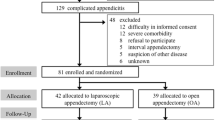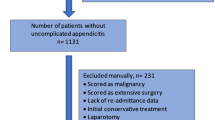Abstract
Purpose
Complicated acute appendicitis is still associated with an increased morbidity. If laparoscopy has been accepted as a valid approach, some questions remain concerning intra-abdominal abscess formation. Routine prophylactic drainage of the abdomen has been proposed. However, this practice remains a matter of debate, poorly validated in the literature. With the present study, we investigated the impact of drainage in laparoscopic appendectomy for complicated appendicitis.
Method
This is a case match study of consecutive patients operated on by laparoscopy in a single institution. One hundred and thirty patients operated for complicated appendicitis (local peritonitis without perforation, with perforation, or with periappendicular abscess) with prophylactic intraperitoneal drainage were matched one by one to 130 patients operated without drainage. Uncomplicated appendicitis and generalized peritonitis were excluded. Primary endpoint was surgical complications and secondary endpoints were transit recovery time and length of hospital stay.
Results
Patients without drain had significantly less overall complications (7.7% vs. 18.5%, p = 0.01). Moreover, the absence of drainage was of significant benefit for transit recovery time (2.5 vs. 3.5 days, p = 0.0068) and length of hospital stay (4.2 vs. 7.3 days, p < 0.0001).
Conclusion
No benefits were observed for prophylactic drainage of the abdominal cavity during emergency laparoscopic treatment of complicated appendicitis. For this reason, this practice may be abandoned.



Similar content being viewed by others
References
Cueto J, Dallemagne B, Vázquez-Frias JA, Gomez S, Delgado F, Trullenque L, Fajardo R, Valencia S, Poggi L, Ballí J, Diaz J, González R, Mansur JH, Franklin ME (2006) Morbidity of laparoscopic surgery for complicated appendicitis: an international study. Surg Endosc 20(5):717–720
Ming PC, Yan TY, Tat LH (2009) Risk factors of postoperative infections in adults with complicated appendicitis. Surg Laparosc Endosc Percutan Tech 19(3):244–248
Garg CP, Vaidya BB, Chengalath MM (2009) Efficacy of laparoscopy in complicated appendicitis. Int J Surg 7(3):250–252
Faiz O, Clark J, Brown T, Bottle A, Antoniou A, Farrands P, Darzi A, Aylin P (2008) Traditional and laparoscopic appendectomy in adults: outcomes in English NHS hospitals between 1996 and 2006. Ann Surg 248(5):800–806
Van Hove C, Hardiman K, Diggs B, Deveney C, Sheppard B (2008) Demographic and socioeconomic trends in the use of laparoscopic appendectomy from 1997 to 2003. Am J Surg 195(5):580–583, discussion 583–584
Paterson HM, Qadan M, de Luca SM, Nixon SJ, Paterson-Brown S (2008) Changing trends in surgery for acute appendicitis. Br J Surg 95(3):363–368
Yau KK, Siu WT, Tang CN, Yang GP, Li MK (2007) Laparoscopic versus open appendectomy for complicated appendicitis. J Am Coll Surg 205(1):60–65
Moberg AC, Berndsen F, Palmquist I, Petersson U, Resch T, Montgomery A (2005) Randomized clinical trial of laparoscopic versus open appendicectomy for confirmed appendicitis. Br J Surg 92(3):298–304
Katkhouda N, Mason RJ, Towfigh S, Gevorgyan A, Essani R (2005) Laparoscopic versus open appendectomy: a prospective randomized double-blind study. Ann Surg 242(3):439–448, discussion 448–450
Aziz O, Athanasiou T, Tekkis PP, Purkayastha S, Haddow J, Malinovski V, Paraskeva P, Darzi A (2006) Laparoscopic versus open appendectomy in children: a meta-analysis. Ann Surg 243(1):17–27
Lin HF, Wu JM, Tseng LM, Chen KH, Huang SH, Lai IR (2006) Laparoscopic versus open appendectomy for perforated appendicitis. J Gastrointest Surg 10(6):906–910
Fukami Y, Hasegawa H, Sakamoto E, Komatsu S, Hiromatsu T (2007) Value of laparoscopic appendectomy in perforated appendicitis. World J Surg 31(1):93–97
Harrell AG, Lincourt AE, Novitsky YW, Rosen MJ, Kuwada TS, Kercher KW, Sing RF, Heniford BT (2006) Advantages of laparoscopic appendectomy in the elderly. Am Surg 72(6):474–480
Sauerland S, Lefering R, Neugebauer EA (2002) Laparoscopic versus open surgery for suspected appendicitis. Cochrane Database Syst Rev 1:CD001546
Kehagias I, Karamanakos SN, Panagiotopoulos S, Panagopoulos K, Kalfarentzos F (2008) Laparoscopic versus open appendectomy: which way to go? World J Gastroenterol 14(31):4909–4914
Katsuno G, Nagakari K, Yoshikawa S, Sugiyama K, Fukunaga M (2009) Laparoscopic appendectomy for complicated appendicitis: a comparison with open appendectomy. World J Surg 33(2):208–214
Tander B, Pektas O, Bulut M (2003) The utility of peritoneal drains in children with uncomplicated perforated appendicitis. Pediatr Surg Int 19:548–550
Stone HH, Hooper CA, Millikan WJ (1978) Abdominal drainage following appendectomy and cholecystectomy. Ann Surg 187:606–612
Magarey CJ, Chant ABD, Rickford CRK (1971) Peritoneal drainage and systemic antibiotics after appendectomy. Lancet 2:179–182
Toki A, Ogura K, Sato Y (1995) Peritoneal lavage versus drainage for perforated appendicitis in children. Surg Today 25(3):207–210
Pessaux P, Msika S, Flamant Y (2003) Risk factors for postoperative infectious complications in noncolorectal abdominal surgery. Arch Surg 138:314–324
Kokoska ER, Silen ML, Webwe TR (1998) Perforated appendicitis in children: risk factors for development of complications. Surgery 124(4):619–626
Alloo J, Gerstle T, Ein SH (2004) Appendicitis in children less than 3 years of age: a 28-year review. Pediatr Surg Int 19:777–779
Neilson IR, Laberge JM, Nguyen LT, Moir C, Doody D, Sonnino RE, Youssef S, Guttman FM (1990) Appendicitis in children: current therapeutic recommendations. J Pediatr Surg 25(11):1113–1116
Narci A, Karaman I, Karaman A, Erdoğan D, Cavuşoğlu YH, Aslan MK, Cakmak O (2007) Is peritoneal drainage necessary in childhood perforated appendicitis?—a comparative study. J Pediatr Surg 42(11):1864–1868
Petrowsky H, Demartines N, Clavien PA (2004) Evidence-based values of prophylactic drainage in gastrointestinal surgery. Ann Surg 240:1074–1085
Dindo D, Demartines N, Clavien PA (2004) Classification of surgical complications: a new proposal with evaluation in a cohort of 6336 patients and results of a survey. Ann Surg 240(2):205–213
Schein M (2008) To drain or not to drain? The role of drainage in the contaminated and infected abdomen: an international and personal perspective. World J Surg 32(2):312–321
Gurusamy KS, Samraj K, Mullerat P, Davidson BR (2007) Routine abdominal drainage for uncomplicated laparoscopic cholecystectomy. Cochrane Database Syst Rev 17(4):CD006004
Wittmann DH, Schein M, Condon RE (1996) Management of secondary peritonitis. Ann Surg 224(1):10–18
Conflicts of interest
None.
Author information
Authors and Affiliations
Corresponding author
Additional information
Author contributions
• Study conception and design: Allemann Pierre, Probst Hervé, Demartines Nicolas
• Acquisition of data: Allemann Pierre
• Analysis and interpretation of data: Allemann Pierre, Probst Hervé, Schäfer Markus
• Drafting of manuscript: Allemann Pierre, Probst Hervé, Schäfer Markus
• Critical revision of manuscript: Demartines Nicolas, Schäfer Markus
Rights and permissions
About this article
Cite this article
Allemann, P., Probst, H., Demartines, N. et al. Prevention of infectious complications after laparoscopic appendectomy for complicated acute appendicitis—the role of routine abdominal drainage. Langenbecks Arch Surg 396, 63–68 (2011). https://doi.org/10.1007/s00423-010-0709-z
Received:
Accepted:
Published:
Issue Date:
DOI: https://doi.org/10.1007/s00423-010-0709-z




